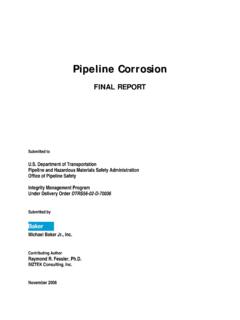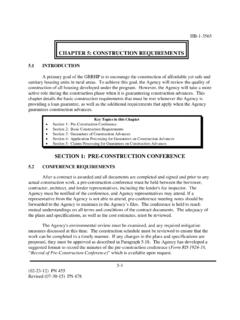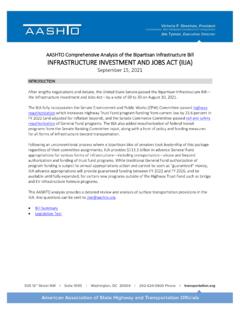Transcription of Pavement Condition Index (PCI) - University of California ...
1 Best Practices for Pavement Pavement Condition Index (PCI) There s More (and Less) to the Score February 2021 The City and County Pavement Improvement Center, supported by SB1 funding through the University of California Institute of Transportation and the Mineta Transportation Institute, is dedicated to increasing Pavement knowledge and technical capability among local government staff, planners, and managers by providing timely, relevant, and practical technical support, training, research, publications, and outreach. report No. UCPRC-BP-2021-01 Local agencies commonly use Pavement Condition Index (PCI) as the primary or sole basis for selecting from the Pavement preservation and rehabilitation strategies in their Pavement management systems (PMS). PCI is a simple, effective communication tool, but when used alone it is insufficient for choosing the right strategy at the right time to maximize the cost-effectiveness of Pavement funding.
2 However, making simple changes to an agency s PMS so it uses the Pavement Condition data that go into calculating a PCI can result in better engineering decisions. Once a Pavement segment in a network is programmed for work, small investments in better project-level site investigations can have big payoffs by producing better information for engineering decisions and by identifying problems that will be costly to resolve when found during construction. How PCI is Calculated PCI is calculated using detailed data related to the Pavement surface distresses observed in Pavement Condition surveys. A Condition survey identifies the distress types within a section of a Pavement (such as one block of city street or one mile of county road), the severity of each distress (how advanced the distress is), and its extent (how widespread the distress is in the section).
3 PCI is calculated as follows, using the detailed type, severity, and extent data: An equation converts the severity and extent of each distress into a so-called deduct value ; different deduct equations are used for the different distress types. All the deduct values obtained across all the distress types are then added up and subtracted from 100. The result is a PCI on a scale of 0 to 100. The equations for calculating deduct values were originally graphical figures developed in the 1970s (see the section History of PCI below) based on the opinions of Pavement experts regarding the relative importance of the severities and extents of different distresses. Those equations have been standardized into ASTM 6433, Standard Practice for Roads and Parking Lots Pavement Condition Index Surveys. Distress Types and Appropriate Treatments Distresses The asphalt-surfaced Pavement distresses for which information is collected can be Best Practices for Pavement Pavement Condition Index (PCI) There s More (and Less) to the Score Page 2 City and County Pavement Improvement Center broadly categorized as follows1: Alligator Cracking Block Cracking Longitudinal and Transverse Cracking Distortions Patching and Utility Cuts Rutting and Depression Raveling Weathering Cracking is the most common and important type of distress and affects all asphalt pavements.
4 And while all the distresses listed above have deduct values, Pavement management should primarily focus on cracking, except where safety is involved (severe rutting, potholes). Cracking can be divided into two main types: age-related cracking and load-related cracking. Age-related cracking, which can occur over an entire Pavement , is caused by oxidation of the asphalt as it ages and becomes unable to handle expansion and contraction from temperature changes without fracturing. This type of cracking has these characteristics: It appears as both transverse (Figure 1) and longitudinal cracks, which eventually become connected to form block cracking. Age-related cracks occur at the top of the asphalt and propagate downward. The entire surface of all asphalt pavements will experience age-related cracking unless they are preserved in a timely manner. 1 From StreetSaver example Figure 1.
5 Transverse cracking (sealed) due to aging Load-related cracking occurs only in the wheelpaths and is caused by asphalt bending under heavy vehicles, which fatigues the asphalt layers. This type of cracking (also called alligator cracking ) has these characteristics: Load-related cracking only occurs on pavements that undergo loading by heavy trucks or buses. Load-related cracking usually starts at the bottom of the asphalt and propagates upward. Cracking will occur in wheelpaths regardless of whether or not preservation treatments are used, although these treatments can help slow the fatigue damage (Figure 2). Potholes are the result of extensive wheelpath fatigue cracking. source/ Best Practices for Pavement Pavement Condition Index (PCI) Page 3 There s More (and Less) to the Score City and County Pavement Improvement Center Figure 2.
6 Load-related fatigue cracking in the wheelpaths due to heavy loading by buses Among the non-cracking distresses, rutting most often occurs when rainwater passes through the cracked asphalt to the underlying base material or subgrade soil. Patches are the main short-term repairs used for fatigue cracking and potholes. Raveling, weathering, rutting, and depressions caused by heavy, slow-moving vehicles are most commonly associated with construction quality and/or asphalt mix design problems. Treatments Identifying age- and load-related cracking and using that information as the primary basis for managing your Pavement will result in better-informed, more cost-effective treatment timing and selection. Preservation treatments, such as slurry seals, chip seals, micro-surfacings, and fog seals, should be applied at approximately 5 to 12-year intervals to slow or, in some cases, help reverse the oxidation that causes age-related cracking.
7 Ideally, these treatments should be placed before transverse and longitudinal cracking appear because they seal the cracks only temporarily. The appropriate time, earlier or later in the approximate window of 5 to 12 years after placement of the asphalt, depends on the severity of the climate region with respect to age-related cracking, the asphalt construction compaction, and the type of asphalt binder. More severe climates are those with hotter summers that accelerate aging and/or colder winters that result in more contraction of the asphalt. Better asphalt compaction results in slower oxidation and greater resistance to cracking. Rubberized and polymer-modified mixes can also improve aging and crack resistance. Local governments should look at their own Pavement Condition survey data to estimate when longitudinal and transverse cracking typically first appear and apply preservation treatments several years before then.
8 Pavements that do not get heavy vehicle loading and have preservation treatments applied in a timely manner can potentially survive for many decades with perpetual Pavement preservation and no rehabilitation necessary. If top-down, age-related cracking has occurred extensively, but has generally not propagated deeper than 2 to 4 inches from the surface, then partial-depth recycling (also called cold in-place recycling ), using either foamed asphalt or engineered emulsion with cement, is typically the best treatment. Pavements failing because of load-related cracking require structural overlays or inlays (also called mill-and-fill ), or full-depth recycling or replacement of the asphalt where the wheelpath cracking is widespread. Best Practices for Pavement Pavement Condition Index (PCI) There s More (and Less) to the Score Page 4 City and County Pavement Improvement Center Managing Pavement networks primarily based on identification of age- and load-related cracking will result in more informed and cost-effective treatment timing and selection.
9 Problems with Relying on Only PCI to Make Pavement Management Decisions Although a PCI can be used as a simple, effective means to communicate overall Pavement Condition to non-technical audiences, it has limitations as an engineering tool for local governments making Pavement -management decisions. Specifically, when a PCI is developed from Condition survey data, a lot of important engineering information is lost, particularly data regarding cracking. If the Same or a Similar PCI Score Results, What s the Tiebreaker? A major deficiency in PCI is that roadway segments can have the same or similar PCI but very different types of distress. Therefore, if only PCI is used, a Pavement preservation or rehabilitation strategy selection could be made for multiple segments without considering what distress types are present or their severities and extents. For these cases, examining the distress types and extents of the distresses and their effect on the Pavement structure, along with other available project-level data, could serve as a tiebreaker to augment PCI in making network-level and project scoping decisions.
10 Table 1 shows an example of two roadway segments with a similar, low PCI. Using PCI alone, the strategy selection for both cases would be rehabilitation . However, the distresses within each segment are significantly different and require different solution strategies. In Section A, the distresses are related to heavy truck and/or bus traffic loading and indicate the Pavement structure may be reaching the end of its structural life. The areas with alligator cracking and potholes will need their existing asphalt removed and replaced. Rutting is low in the section, indicating that water coming through the cracks has not yet caused weakening of the base or subgrade. Therefore, the strategies to be considered would generally include (i) a thick mill-and-fill or overlay after repair of the damaged wheelpaths with digouts, (ii) full-depth recycling, or (iii) removal and replacement of the asphalt.










